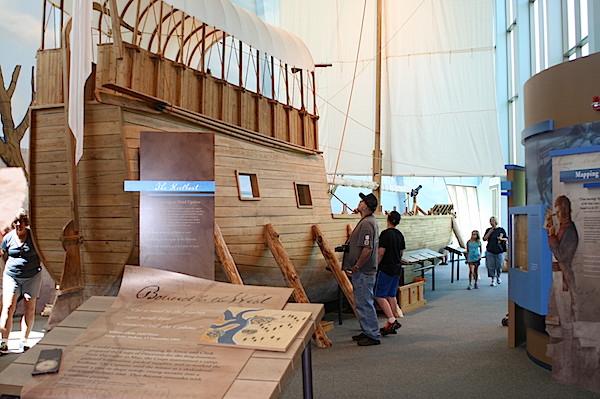
The Lewis and Clark State Historic Site in Illinois offers a great primer on Lewis and Clark's great adventure/Courtesy photo
Traveling to St. Louis eager to learn about Lewis and Clark? Then take this half-hour's drive to Hartford, Illinois, where this great adventure began, at Camp River DuBois and the Lewis and Clark State Historic Site.
If you're driving to Hartford from downtown St. Louis, you must first turn eastward on I-255, and cross the mighty, turbid Mississippi, until the Gateway Arch is but a silver ribbon in your rearview mirror. Next comes the noisy clutter of East St. Louis, Illinois, but as the highway veers northward, the landscape gradually quiets, yielding clusters of farm buildings and expansive fields of soybean, milo, and corn.
Once you arrive at the Lewis and Clark State Historic Site, the wooden fort that marks Camp River DuBois looks rather diminutive by comparison.
This center is one of the larger sites on the Lewis and Clark National Historic Trail, according to Karla Sigala, an interpretive specialist based at trail headquarters in Omaha, Nebraska. Camp River Dubois is among a number of destinations that evolved in preparation for The Lewis and Clark Bicentennial celebration (January 2003-August 2006). With $8 million of state and federal funds, the facility began to take shape, giving rise to the impressive visitor's center that opened in May 2004. Since then, they've welcomed 100,000 visitors annually.
Setting Out To Explore
Back in 1803, Lewis and Clark were given ample homework by President Thomas Jefferson: The Corps of Discovery was to improve mapping of the lands west of the Mississippi, to inventory plants and animals they encountered, to develop trade relations with the Native Americans, and to determine the existence of the Northwest Passage.
'They were still hoping to find the Northwest Passage,' notes assistant site manager Cindy Upchurch. 'And they'd heard about mountains but what they knew were the Appalachians, not the Rockies. Those were mind-blowing.'
The fort at Camp River Dubois was built in the winter of 1803, during the staging of the journey, though exactly where it stood remains a mystery. Site Superintendent Brad Winn point outs, 'No artifacts have been found, no clear 'X' marks the spot.' But historians do know it was near the confluence of the Missouri and Mississippi rivers. Here Clark worked with the soldiers from December 1803 to May 1804, gathering provisions, creating an Army unit of men, and determining how best to economically pack eight tons of goods into two pirogues (flat-bottomed, canoe-like boats) and a 55-foot keelboat barely eight feet in width.
Today, you'll find a replica of that fort and its barracks, enclosed by a tall wooden picket fence, along with the airy, 14,000 square-foot interpretive center that tells the story that led up to the expedition's preparations.

During the summer months demonstrations are held out on the park grounds/Courtesy photo
Supplies Tell The Story
Seeing the long, diverse list of supplies that were gathered and how masterfully it was assembled into this small flotilla is one surprising pleasure of this center. Who would have guessed the Corps carried items like handkerchiefs, peace medals, trade goods, mapping equipment, brass compasses, copper kettles, snuff, quill pens, even blank journals for recording their travels. The exhibits help you appreciate how every detail of the journey was considered. Parents will like how kid-friendly exhibits are too, with plenty of objects kids can examine and handle.
Even better is viewing the replica keelboat, fully furled with a 30-foot mast and sliced in half so as to demonstrate how intricately objects fit together. Winn says William Clark's field notes, which didn't resurface until the 1950s, gave historians great insight into this valuable winter of preparation before the readied boats launched from the camp in the spring of 1804, and sailed to St. Charles, Missouri.
Life On The Frontier
In addition to learning about the Corps of Discovery, visitors can gain insight into life on the western frontier. Step into the pioneer's cabin and admire the hand-hewn cedar logs and shingled roof tightly held in place by sapling branches.
Upchurch says she's been surprised the branches work so well, 'I didn't think they'd hold up under the wind and rain we get, but we haven't lost a single shingle in five years.'
You can also sit and relax in a wooden rocker. As you look around at the simple objects assembled, you begin to appreciate the self-reliance pioneers developed to survive in the wilderness.
As for the Corps, notes Winn, at the end of their five-year trek, Sergeant John Ordway returned to this corner of Illinois to look in on Camp River DuBois where their journey had begun. There he discovered a solitary figure, the local washerwoman who had scrubbed and mended clothes for the soldiers during that blustery winter of 1803, still tending the fort. She had made it her home now, a plantation of sorts, living on the edge of the western frontier that would be forever changed by the Corps of Discovery.

Inside stands a replica of the keel boat the Corps of Discovery used/Courtesy photo
If You Go:* Lewis and Clark State Historic Site '¢ http://www.campdubois.com/
* One Lewis and Clark Trail, Hardford, Illinois, 62048 '¢ (618) 251-5811
* Open Wednesday-Sunday from 9 a.m.-5 p.m.
* Admission is free.
For more information on the 125 sites that encompass the Lewis and Clark National Historic Trail, go to: http://www.nps.gov/lecl/planyourvisit/leclvchq2b.htm
Want to read Gary Moulton's edited version of Lewis and Clark's journals? They're considered the most accurate and inclusive edition ever published. Go to The Lewis and Clark Expedition online at www.lewisandclarkjournals.unl.edu

 Support Essential Coverage of Essential Places
Support Essential Coverage of Essential Places







Comments
link to the journals doesnt work
Try it now, Kurt.